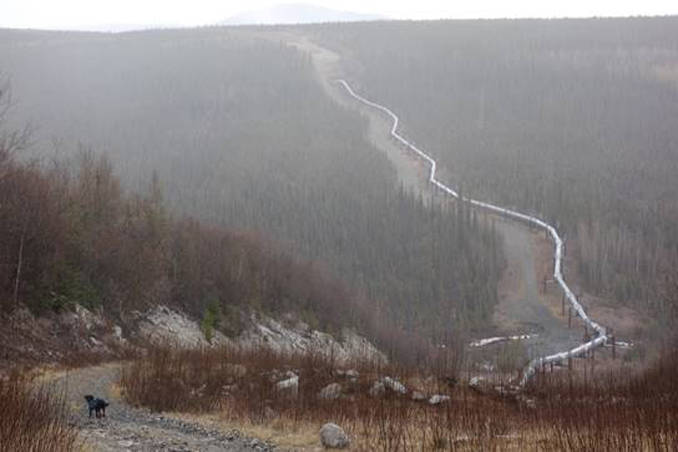When I walked this same path 20 years ago, I averaged six miles each day. After a few weeks in 2017 of hiking the path of the Trans-Alaska Pipeline, it seems easy to do 10 miles a day.
Back then, sometimes my backpack weighed 60 pounds. I’m trying to keep it half that weight now. I started from Valdez with a load of 32 pounds.
Most of the reduction is due to clever people who have engineered lighter gear because consumers wanted it, and because of breakthroughs in materials available to designers.
Jay Cable of Fairbanks pointed me to a few of my biggest weight savers. He recommended a single-compartment backpack that resembles a stuff sack (no extra bag on top, few pockets, not much padding on the hips or shoulder straps). It is about one quarter the weight of the external frame pack I used in 1997.
Jay also recommended my three-person nylon tent. It’s roomy enough to squeeze in three people and has been a luxury for just me and Cora in the early going. The fabric is breathtakingly delicate, not much thicker than tissue paper. The zippers seem like they belong on a windbreaker. I’ve held my breath a few times while shoving it into its bag, but so far so good. The tent weighs less than four pounds.
Another weight saver has been my water purifier, a sterilizing pen that magically kills bad things in the mountain and swamp water I’ve been drinking. It performs this function with a dose of ultraviolet light. It’s one-third the weight of the pump filter with a ceramic core I used last time.
Because we live in a golden era of worldwide shipping, when I sit against a black spruce, I eat apricots from Turkey and dried mangos from the Philippines, almonds from California and cranberries from Massachusetts. I bought them all at Fairbanks stores and made them part of my food drops.
My menu is quite similar to 20 years ago, with two notable improvements. One is instant coffee in single-serving packs. The other is Alaska-based freeze-dried foods; there is no treat that tops smoked sockeye salmon chowder at the end of the day.
For all the innovations I carry, my communications equipment weighs three times as much as it did in 1997. Then, I had a palmtop computer that ran on AA batteries. I needed to find a phone line to send these columns, but it was the size of a paperback book and weighed less.
Now I’m carrying my first-ever cell phone, a tablet that doesn’t like the cold and a pocket camera. All are hungry for electricity, which my friend John Arntz gifted me in the form of a portable battery charger the size of two cell phones pressed together. All of these electronics are much heavier than the setup 20 years ago, but allow me to send columns from the tent when there is a cellular signal.
My right front pants pocket holds a digital camera. With a large memory card, the number of photos I can take seems infinite. That’s quite a change from 20 years ago, when I shot slide film in groups of 24 and 36 and did not see the shots until weeks, sometimes months later.
My favorite new gizmo by far is my pocket GPS with color maps installed. It also allows me to communicate by satellite anytime, anywhere.
The GPS has been my little orange friend on lonely stretches. It sends a blip to satellites every few hours so people can track me. It has also allowed me to check in with my wife every night, and chat during the day with John and other friends. Biologist Susan Sharbaugh has faithfully sent me baseball scores every night from Bloomfield Hills, Michigan. Yay.
Twenty years ago, there was no help available from intelligent hunks of plastic and metal orbiting 500 miles overhead. What will the next 20 years bring?
• Since the late 1970s, the University of Alaska Fairbanks’ Geophysical Institute has provided this column free in cooperation with the UAF research community. Ned Rozell is a science writer for the Geophysical Institute.

